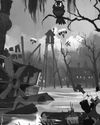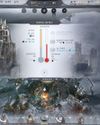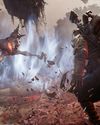
It is the blessing and the curse of the younger sibling. On the one hand, the benefit of walking on ground already broken by the elder child, pre-flattened for ease of passage. On the other, the identity-smothering disappointment of the hand-me-down.
Ubisoft Toronto was built in the shadow of the publisher’s flagship studio in Montreal—an enormous ideas factory responsible for Splinter Cell, Prince of Persia, and Assassin’s Creed, the very foundations of the Ubi empire. Montreal’s brightest lights were sent to Ontario’s capital to establish the new outpost: Producer extraordinaire Jade Raymond, who has since specialized in manifesting AAA studios, and the creative director Maxime Béland.
The latter brought with him a blueprint for what was, back in 2010, a shockingly modern take on the stealth game. At Ubi Montreal, Béland had led development on Splinter Cell: Conviction, a series reboot that had applied his experience with Rainbow Six: Vegas, a cover shooter, to espionage. The result was a game that played with light and shadow, but paradoxically hinged on a move called ‘mark and execute’—which saw Sam Fisher plug enemies in slo-mo as if they were melons lined up on a plank of wood. Conviction was acclaimed but controversial—a wobbly and dangerous jumping off point for a new studio.
This story is from the {{IssueName}} edition of {{MagazineName}}.
Start your 7-day Magzter GOLD free trial to access thousands of curated premium stories, and 9,000+ magazines and newspapers.
Already a subscriber ? Sign In
This story is from the {{IssueName}} edition of {{MagazineName}}.
Start your 7-day Magzter GOLD free trial to access thousands of curated premium stories, and 9,000+ magazines and newspapers.
Already a subscriber? Sign In

"The War Within itself has kept me coming back most evenings too"
WORLD OF WARCRAFT remains my jailer, and I couldn't be more pleased about it

OK BUILDER
SATISFACTORY is the new titan in building and crafting games

HELL YES
DIABLO IV: VESSEL OF HATRED is a transformative expansion

MOUSE: PI FOR HIRE
This mouse wants to be more than just a gimmick

WINDBLOWN
Dead Cells dev's new roguelike has me afraid for my free time

NO MORE ROOM IN HELL 2
As the zombie horde surrounded me just moments after taking down my two remaining teammates, the writing was really on the wall. Armed with just a chef's knife, it was clear I stood no chance, but I was going down swinging, hoping for a miracle... it didn't come.

OWNED BY STEAM
VALVE cordially reminds you that your games aren't yours

CURSE OF THE AZURE BONDS
These classic games haven't aged badly, but I sure have.

DEEP FREEZE
Endure a blizzard of tough choices and rough consequences in FROSTPUNK 2

NEW HORIZONS
Building up REMNANT 2 outside the live service game grinder